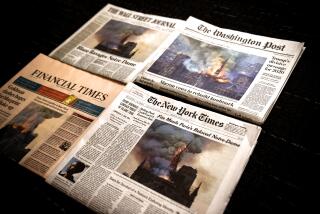The New Yorker’s Change Creates a World of Concern
- Share via
NEW YORK — Perhaps the most surprising effect of the impending change of editors here at the New Yorker--for only the second time in 62 years--is the concern the news created the world around. It is astonishing that a magazine with a local name and a circulation that has never reached 600,000 has come to mean so much to readers and writers and to seem to express to foreigners something important about America and Americans.
One reason for its influence, I think, is that the New Yorker has always been a couple of steps ahead--but in the direction America was going. When Harold Ross described the audience he didn’t want in 1925, in the phrase, “Not for the Old Lady from Dubuque,” most Americans were living in and around great cities--in what we now call “standard metropolitan statistical areas”--but official American culture was pretending we were all living happily on farms or in small towns. Our popular literature, like our politics, was affected by sham and neglected much American experience. Though I doubt that Ross (whom I never met) thought like a sociologist, his magazine took its audience beyond other publications, and when the reader got there he realized he was home. The phrase “the New Yorker short story” dates, I think, from the 1930s, and described work that was bewilderingly inconclusive. Yet in no time at all the stories of John O’Hara or John Cheever--to name only two New Yorker writers--seemed crystalline expressions of their time, and they have outlasted it. I am sure that our current bewilderers will clarify themselves in a trice.
Persisting nostalgia for small communities overlooks the constraints they enforced--courthouse gangs were only part of it. Pressures, blatant and subtle, were particularly severe on the press. Ross’ insistence on the complete separation of editorial and business departments was a notable innovation, a policy whose most famous test came when chemical manufacturers threatened to withdraw their advertising if the New Yorker published Rachel Carson’s “Silent Spring.” William Shawn, the editor who succeeded Ross--and whose unforeseen and unexpected departure has us all shocked, perplexed and grieved--published anyhow. I suppose that incident, too, is another case of the magazine’s being ahead, for Carson’s revelation of the destructiveness of pesticides was investigative journalism before Americans used the expression.
The quality I am describing, I suppose, is honesty--undogmatic, non-sectarian, and, above all, unself-conscious. I can’t imagine Shawn, whom I do know, lecturing about the fearless pursuit of truth, but then the nature of great editing--like the nature of greatness of any kind--always includes a mystery. And virtue is complicated. It is certainly easier to write or print what is expected or agreed on than to write or elicit writing that achieves the genuine, because when you set out after the authentic you do not know what you will find. Flimflam, by contrast, is readymade and prepackaged.
Does this sound solemn? It shouldn’t. Truth is often funny. So is the New Yorker.
Does it sound like self-praise? It isn’t meant to. I didn’t invent the magazine.
Does it sound like a eulogy? We on the staff feel we are at a turning point--a moment of stock-taking and reflection and gratitude for past leadership--but not, we hope, at an end.
More to Read
Sign up for our Book Club newsletter
Get the latest news, events and more from the Los Angeles Times Book Club, and help us get L.A. reading and talking.
You may occasionally receive promotional content from the Los Angeles Times.







